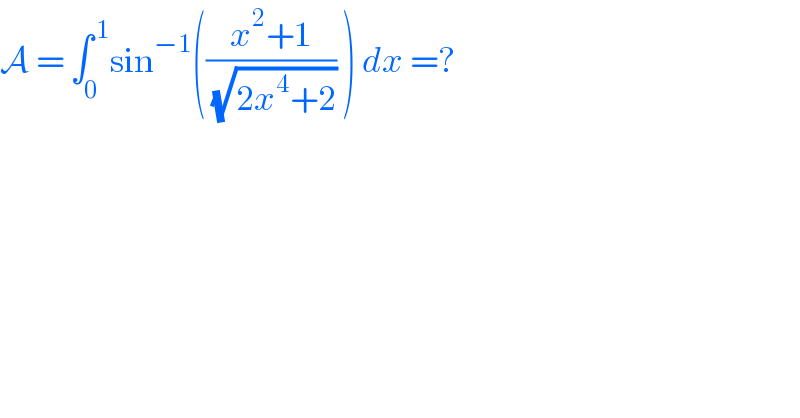
Question and Answers Forum
Question Number 133786 by bobhans last updated on 24/Feb/21

Answered by john_santu last updated on 24/Feb/21
![Using the Pythagorean theorem arcsin (((x^2 +1)/( (√(2x^4 +2)))) )=arctan (((1+x^2 )/(1−x^2 )) ) A=∫_0 ^( 1) arctan (((1+x^2 )/(1−x^2 )) )dx Use by integration by parts A= x arctan (((1+x^2 )/(1−x^2 ))) ∣_0 ^1 −2∫_0 ^( 1) (x^2 /(x^4 +1)) dx A= (π/2)−[∫_0 ^( 1) ((1+(1/x^2 ))/(x^2 +(1/x^2 ))) dx +∫_0 ^( 1) ((1−(1/x^2 ))/(x^2 +(1/x^2 ))) dx ] A=(π/2)−(1/(2(√2))) (π+ln (3)−2(√2) ) A ≈ 1.0833](Q133790.png)
| ||
Question and Answers Forum | ||
Question Number 133786 by bobhans last updated on 24/Feb/21 | ||
 | ||
Answered by john_santu last updated on 24/Feb/21 | ||
![Using the Pythagorean theorem arcsin (((x^2 +1)/( (√(2x^4 +2)))) )=arctan (((1+x^2 )/(1−x^2 )) ) A=∫_0 ^( 1) arctan (((1+x^2 )/(1−x^2 )) )dx Use by integration by parts A= x arctan (((1+x^2 )/(1−x^2 ))) ∣_0 ^1 −2∫_0 ^( 1) (x^2 /(x^4 +1)) dx A= (π/2)−[∫_0 ^( 1) ((1+(1/x^2 ))/(x^2 +(1/x^2 ))) dx +∫_0 ^( 1) ((1−(1/x^2 ))/(x^2 +(1/x^2 ))) dx ] A=(π/2)−(1/(2(√2))) (π+ln (3)−2(√2) ) A ≈ 1.0833](Q133790.png) | ||
| ||